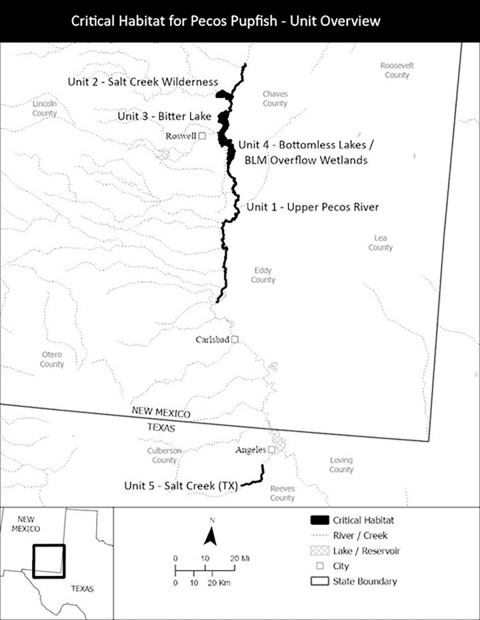The U.S. Fish and Wildlife Service seeks data and comments on the proposal to list the Pecos pupfish as threatened with an accompanying 4(d) rule and on the proposal to designate critical habitat under the Endangered Species Act. The proposed rule also serves as the Service’s 12-month finding on a petition to federally protect the Pecos pupfish. The proposed rule is now available in the Reading Room for public inspection and will be posted in the Federal Register tomorrow, opening a 60-day public period through Jan. 21, 2025.
The Pecos pupfish is a desert fish endemic to the Pecos River Basin. The fish occurs in diverse water environments, both still and running water, including wetlands, sinkholes, streams, springs and the Pecos River mainstem. Historically the species was found in the Pecos River and adjacent floodplain from Chaves County, New Mexico to Terrell County, Texas. Now the species’ range is limited to Chaves County, New Mexico and an isolated population in Salt Creek in Reeves County, Texas.
The biggest threat to the Pecos pupfish is the non-native fish, sheepshead minnow, introduced into the rivers in the 1970s and 1980s. The Pecos pupfish and the sheepshead minnow readily hybridize. The hybrid fish is larger, grows faster and outcompetes the Pecos pupfish species for resources. Additional threats to the Pecos pupfish are the impacts of climate change climate change
Climate change includes both global warming driven by human-induced emissions of greenhouse gases and the resulting large-scale shifts in weather patterns. Though there have been previous periods of climatic change, since the mid-20th century humans have had an unprecedented impact on Earth's climate system and caused change on a global scale.
Learn more about climate change , which lead to the loss and decline of surface-waters and the degradation of water quality.
“The best available data indicate that the Pecos pupfish is threatened, facing multiple risks to its survival,” said Amy Lueders, the Service’s Southwest Regional Director. “The most secure populations of the species are found across public lands in New Mexico and Texas. In fact, if you get close to the sinkholes at Bottomless Lake State Park in New Mexico, you may get a chance to see the rare pupfish.”
The fish is small, no bigger than two inches and varies in color from gray to-brown to shiny blue. Individuals of the species vary in their appearances, which may provide adaptation advantages in the various, isolated occupied habitats. For instance, Pecos pupfish found in sinkholes have larger heads with mouths found lower on their heads compared to those found in marshland habitats. These differences in body shapes allows for more efficient feeding.
The Service is proposing 136 river miles and 26,555 acres of five occupied units of critical habitat for the Pecos pupfish in Chaves and Eddy counties, New Mexico, and Culberson and Reeves counties, Texas. The river miles are lands surrounding the river and the proposed acres are numerous isolated sinkholes and wetland areas, representing a mix of federal, state, and private lands. Three of the units overlap with existing critical habitat for six other federally listed species.
Critical habitat identifies geographic areas containing features essential for the conservation of a threatened or endangered species, and which may require special management considerations or protection. Designation of critical habitat does not affect land ownership, nor does it establish a refuge or preserve, and designation has no impact on private landowners taking actions on their land that do not require federal funding or federal permits.
The proposed 4(d) rule would provide for the conservation of the Pecos pupfish by focusing on captive propagation in Texas, enhancing the genetic security of the pupfish in Salt Creek, Texas, and allowing the Texas Parks and Wildlife Department to conduct research on and relocate captive reared Pecos pupfish in Texas. A 4(d) rule is one of many tools in the Endangered Species Act (ESA) that provides tailored protections for threatened species to facilitate recovery and prevent further decline.
The Service is committed to collaborative conservation, transparency, and science-driven ESA findings. Supporting materials, such as the species status assessment report, are available on the Service’s website at ecos.fws.gov/ecp/species/5162, at regulations.gov at Docket No. FWS-R2-ES-2024-0143, or both. The Service invites comments or information from other governmental agencies, Native American Tribes, the scientific community, industry, or any other interested parties concerning this proposed rule. The public comment period runs through Jan. 21, 2025.
Native aquatic ecosystems contain some of the highest levels of biodiversity in the Southwest. Their protection and conservation are critical to the survival of many species of aquatic insects, fish, amphibians, reptiles, waterfowl and other wildlife, as well as humans. When the health and stability of aquatic habitats is improved, it benefits all life that depends on these water resources.






